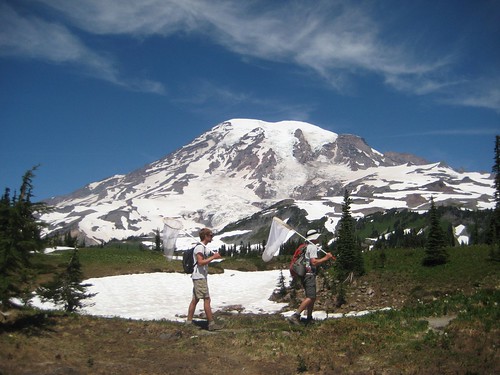
Volunteers traversing the North Cascades Mountains looking to track butterflies. Photo credit: National Park Service
Have you ever seen a cool bird in your backyard and wondered if there was some way to share what you saw with others? Better yet, have you thought about sharing your observations and having them used to help study and conserve those birds? These thoughts are an indicator that you might have the makings of a great citizen scientist!
The Forest Service is engaged in a wide variety of citizen science projects that encourage public involvement in natural and cultural resource science and conservation. Volunteers can contribute by forming research questions, collecting and analyzing data, or interpreting results. If you have a sense of wonder and discovery, citizen science may be for you.
Citizen science can help in conservation and protecting natural resources in two ways: increasing scientific knowledge just like conventional research; and creating a conversation about scientific information and policy and to encourage public input and action.
Many scientific projects would be difficult to research without the help of volunteers because of their size, complexity, or cost. Volunteers can contribute in many ways including helping to track patterns in space and time of one or more parts of the ecosystem, or in the discovery of species or importantcultural resources. At the same time, getting local communities engaged in projects can increase the relevancy of scientific research locally and can foster environmental stewardship. It can also build a better understanding between the community, scientists and decision makers about social aspects in environmental issues.
Many organizations rely on the best available science in order to make management decisions. However, the best scientific information does not necessarily come from peer-reviewed scientific publications, rather it is the best scientific information available to answer the questions raised.
Data integrity is achieved in the same way that it is in any research project, through standardized sampling procedures. Similar quality assurance and controls are used for both citizen science and conventional science and include training, collection of duplicate samples, and post-data collection analyses.
Your involvement matters.
The Forest Service very much wants to engage communities in caring for their land and natural resources. Every year, tens of thousands of volunteers take to the forests, grasslands, wetlands, coasts–and their own backyards–to contribute high quality data for science.
When the public is involved in land and resource management through citizen science, it can foster the connection between scientific discovery and public interest. So, how will you contribute to the places you love?

Volunteers walking the Olympic National Forest to monitor coastal martens. Photo credit: Adventurers and Scientists for Conservation
No comments:
Post a Comment
Note: Only a member of this blog may post a comment.